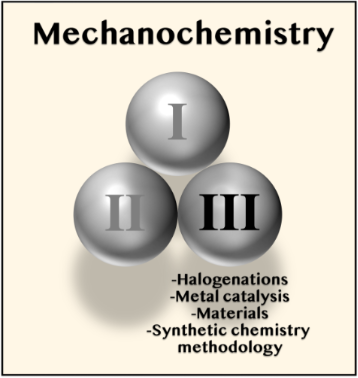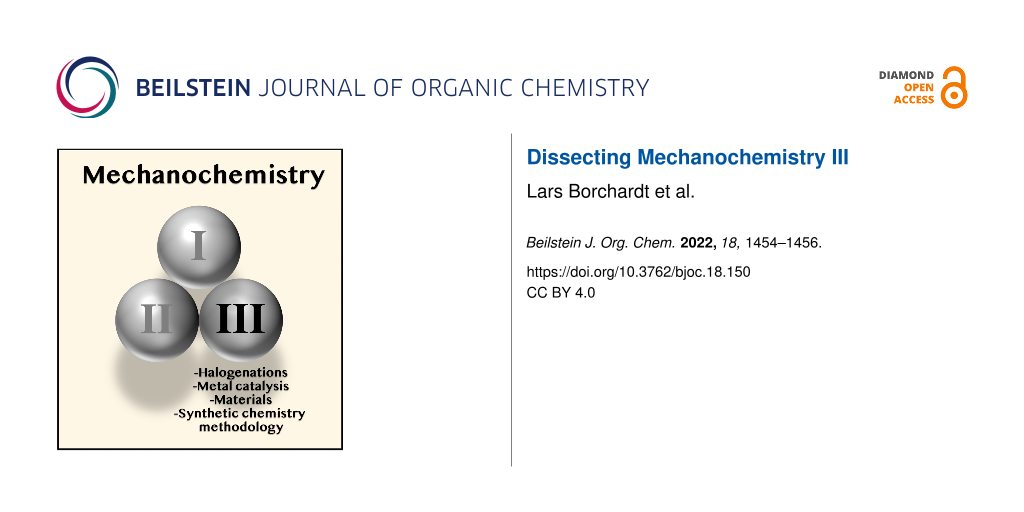
Graphical Abstract
In the past ten years, the use of mechanochemical techniques (e.g., grinding, milling, extrusion, pulsed ultrasonication, resonant acoustic mixing, etc.) have widespread in the field of organic chemistry, enabling the development of new and more sustainable protocols for chemical synthesis [1,2]. Within this period, the Beilstein Journal of Organic Chemistry has organized two Thematic Issues (i.e., Mechanochemistry and Mechanochemistry II) to facilitate the open dissemination of the best research in the field of synthetic organic mechanochemistry. The great success of these past initiatives encouraged us to organize Mechanochemistry III, a new Thematic Issue in which the readership of the journal will find a collection of full research papers, letters and, for the first time, a Perspective article.
In more detail, the readers will find new mechanochemical protocols for the halogenation of organic substrates. For example, Banerjee and co-workers reported the mono-, di-, and trihalogenation of aromatics by controlling the stoichiometry of the N-halosuccinimide (NXS) and PEG-400 as the grinding auxiliary in a mechanical grinder (Scheme 1a) [3].
Scheme 1: a) Mechanochemical PEG-400-assisted halogenation of phenols and anilines using NXS. b) Halogenation of azobenzenes with NXS.
Scheme 1: a) Mechanochemical PEG-400-assisted halogenation of phenols and anilines using NXS. b) Halogenation...
N-Halosuccinimides were also key reagents to develop the mechanochemical halogenation of azobenzenes as studied by Ćurić and co-workers [4]. They demonstrated how, depending on the azobenzene structure, the halogenation of the C–H bonds with NBX occurred in the presence of Pd(II) catalysts or under metal-free conditions (Scheme 1b). Similarly, in the absence of metal catalysts, N-fluorobenzenesulfonimide (NFSI) was found to act as a mild fluorinating reagent for activated aromatics by mechanochemistry [5]. Such a collective effort to access halogenated substrates is understandable, owning the synthetic value of organic halides as substrates in multiple reactions. For instance, within this Thematic Issue, the synthetic relevance of aryl halides was evidenced during the development of a protocol for the solid-state palladium-catalyzed borylation reported by Kubota, Ito, and co-workers (Scheme 2) [6].
Scheme 2: Mechanochemical palladium-catalyzed borylation protocol of aryl halides.
Scheme 2: Mechanochemical palladium-catalyzed borylation protocol of aryl halides.
Moreover, Štrbac and Margetić used dibrominated polycyclic imides as substrates to generate reactive alkenes, which could be trapped in situ by several dienes through Diels−Alder cycloadditions by ball milling (Scheme 3) [7].
Scheme 3: 1,2-Debromination of polycyclic imides, followed by in situ trapping of the dienophile by several dienes.
Scheme 3: 1,2-Debromination of polycyclic imides, followed by in situ trapping of the dienophile by several d...
Further, Moores and co-workers synthesized phosphorus-bridged heptazine-based carbon nitrides (g-h-PCN) from an initial mechanical treatment of trichloroheptazine and Na3P, once again highlighting the importance of halogenated organic molecules as building blocks for graphitic heptazine materials (Scheme 4) [8].
Scheme 4: Synthesis of g-h-PCN from sodium phosphide and trichloroheptazine mediated by mechanochemistry.
Scheme 4: Synthesis of g-h-PCN from sodium phosphide and trichloroheptazine mediated by mechanochemistry.
Another halogenated molecule, 2,3-dichloro-5,6-dicyano-1,4-benzoquinone (DDQ), proved to be an appropriate oxidant for C–N couplings towards the synthesis of 1,2-disubstituted benzimidazoles and quinazolin-4(3H)-one derivatives under mechanochemical conditions, as evidenced by Mal and co-workers (Scheme 5) [9].
Scheme 5: Mechanochemical intra- and intermolecular C–N coupling reactions using DDQ as an oxidant.
Scheme 5: Mechanochemical intra- and intermolecular C–N coupling reactions using DDQ as an oxidant.
However, the findings within Mechanochemistry III span beyond the synthesis or the use of halogenated compounds and include the mechanochemical preparation of isocyanides [10], formylated and acetylated amines [11], and the mechanosynthesis of unsymmetrical salens ligands for preparing metal–salen catalysts [12]. This illustrates the broad applicability of mechanochemical activation to advance chemical synthesis on various fronts. Therefore, we hope you enjoy reading the variety of manuscripts in this Thematic Issues as much as we enjoyed editing it, which was only possible thanks to the impeccable assistance by the Editorial Team of the Beilstein-Institut.
Lars Borchardt and José G. Hernández
Bochum, Medellín, October 2022
ORCID® iDs
Lars Borchardt - https://orcid.org/0000-0002-8778-7816
José G. Hernández - https://orcid.org/0000-0001-9064-4456
References
-
Friščić, T.; Mottillo, C.; Titi, H. M. Angew. Chem., Int. Ed. 2020, 59, 1018–1029. doi:10.1002/anie.201906755
Return to citation in text: [1] -
Ardila-Fierro, K. J.; Hernández, J. G. ChemSusChem 2021, 14, 2145–2162. doi:10.1002/cssc.202100478
Return to citation in text: [1] -
Das, D.; Bhosle, A. A.; Chatterjee, A.; Banerjee, M. Beilstein J. Org. Chem. 2022, 18, 999–1008. doi:10.3762/bjoc.18.100
Return to citation in text: [1] -
Barišić, D.; Pajić, M.; Halasz, I.; Babić, D.; Ćurić, M. Beilstein J. Org. Chem. 2022, 18, 680–687. doi:10.3762/bjoc.18.69
Return to citation in text: [1] -
Hernández, J. G.; Ardila-Fierro, K. J.; Barišić, D.; Geneste, H. Beilstein J. Org. Chem. 2022, 18, 182–189. doi:10.3762/bjoc.18.20
Return to citation in text: [1] -
Kubota, K.; Baba, E.; Seo, T.; Ishiyama, T.; Ito, H. Beilstein J. Org. Chem. 2022, 18, 855–862. doi:10.3762/bjoc.18.86
Return to citation in text: [1] -
Štrbac, P.; Margetić, D. Beilstein J. Org. Chem. 2022, 18, 746–753. doi:10.3762/bjoc.18.75
Return to citation in text: [1] -
Fiss, B. G.; Douglas, G.; Ferguson, M.; Becerra, J.; Valdez, J.; Do, T.-O.; Friščić, T.; Moores, A. Beilstein J. Org. Chem. 2022, 18, 1203–1209. doi:10.3762/bjoc.18.125
Return to citation in text: [1] -
Bera, S. K.; Bhanja, R.; Mal, P. Beilstein J. Org. Chem. 2022, 18, 639–646. doi:10.3762/bjoc.18.64
Return to citation in text: [1] -
Basoccu, F.; Cuccu, F.; Casti, F.; Mocci, R.; Fattuoni, C.; Porcheddu, A. Beilstein J. Org. Chem. 2022, 18, 732–737. doi:10.3762/bjoc.18.73
Return to citation in text: [1] -
Casti, F.; Mocci, R.; Porcheddu, A. Beilstein J. Org. Chem. 2022, 18, 1210–1216. doi:10.3762/bjoc.18.126
Return to citation in text: [1] -
Zuo, S.; Zheng, S.; Liu, J.; Zou, A. Beilstein J. Org. Chem., in press.
Return to citation in text: [1]
| 1. | Friščić, T.; Mottillo, C.; Titi, H. M. Angew. Chem., Int. Ed. 2020, 59, 1018–1029. doi:10.1002/anie.201906755 |
| 2. | Ardila-Fierro, K. J.; Hernández, J. G. ChemSusChem 2021, 14, 2145–2162. doi:10.1002/cssc.202100478 |
| 6. | Kubota, K.; Baba, E.; Seo, T.; Ishiyama, T.; Ito, H. Beilstein J. Org. Chem. 2022, 18, 855–862. doi:10.3762/bjoc.18.86 |
| 5. | Hernández, J. G.; Ardila-Fierro, K. J.; Barišić, D.; Geneste, H. Beilstein J. Org. Chem. 2022, 18, 182–189. doi:10.3762/bjoc.18.20 |
| 4. | Barišić, D.; Pajić, M.; Halasz, I.; Babić, D.; Ćurić, M. Beilstein J. Org. Chem. 2022, 18, 680–687. doi:10.3762/bjoc.18.69 |
| 3. | Das, D.; Bhosle, A. A.; Chatterjee, A.; Banerjee, M. Beilstein J. Org. Chem. 2022, 18, 999–1008. doi:10.3762/bjoc.18.100 |
| 10. | Basoccu, F.; Cuccu, F.; Casti, F.; Mocci, R.; Fattuoni, C.; Porcheddu, A. Beilstein J. Org. Chem. 2022, 18, 732–737. doi:10.3762/bjoc.18.73 |
| 9. | Bera, S. K.; Bhanja, R.; Mal, P. Beilstein J. Org. Chem. 2022, 18, 639–646. doi:10.3762/bjoc.18.64 |
| 8. | Fiss, B. G.; Douglas, G.; Ferguson, M.; Becerra, J.; Valdez, J.; Do, T.-O.; Friščić, T.; Moores, A. Beilstein J. Org. Chem. 2022, 18, 1203–1209. doi:10.3762/bjoc.18.125 |
| 7. | Štrbac, P.; Margetić, D. Beilstein J. Org. Chem. 2022, 18, 746–753. doi:10.3762/bjoc.18.75 |
| 11. | Casti, F.; Mocci, R.; Porcheddu, A. Beilstein J. Org. Chem. 2022, 18, 1210–1216. doi:10.3762/bjoc.18.126 |
© 2022 Borchardt and Hernández; licensee Beilstein-Institut.
This is an open access article licensed under the terms of the Beilstein-Institut Open Access License Agreement (https://www.beilstein-journals.org/bjoc/terms), which is identical to the Creative Commons Attribution 4.0 International License (https://creativecommons.org/licenses/by/4.0). The reuse of material under this license requires that the author(s), source and license are credited. Third-party material in this article could be subject to other licenses (typically indicated in the credit line), and in this case, users are required to obtain permission from the license holder to reuse the material.








